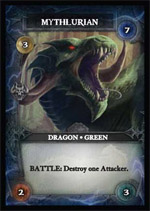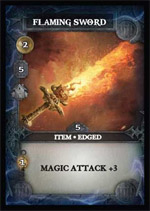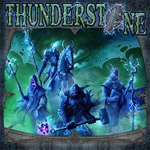In the previous post we looked at Dominion and its role in establishing the deck-building card game as an accessible alternative to collectible card games such as Magic: The Gathering. In this post we look at the second title to adopt the format, the dungeon adventure Thunderstone.
Thunderstone was created by game designer Mike Elliott and published by Alderac Entertainment Group in 2009 on the heels of Dominion’s success. The game supports solo play or up to 5 for competitive play. The publisher claims an average game length of 60 minutes although it has been my experience that certain setup conditions may make the game take much longer. The mechanics of Thunderstone are so similar to Dominion that many initially dismissed it as simply a clone or rip-off of the original deck building concept. At this point those accusations have largely subsided and Thunderstone is recognized as the second entry in the new genre of deck building card games.
 Thunderstone is targeted directly at Dominion’s greatest perceived weakness, its theme. Thunderstone has theme in spades. Players are financiers of a dungeon expedition looking to recover one of the lost Thunderstones. The card art is dynamic fantasy subject matter and well executed, even if somewhat familiar .
Thunderstone is targeted directly at Dominion’s greatest perceived weakness, its theme. Thunderstone has theme in spades. Players are financiers of a dungeon expedition looking to recover one of the lost Thunderstones. The card art is dynamic fantasy subject matter and well executed, even if somewhat familiar .
Players begin the game with 12 cards in a personal deck consisting of militia, daggers, iron rations, and torches. A player starts his or her turn with a hand of 6 cards and an important choice; visit the village to purchase improved gear, weapons, spells, light sources, etc… or use their current hand to delve into the dungeon and do battle with the monsters waiting in the dark. Defeated monsters are added to a player’s personal discard deck and are usually worth experience, victory points, and sometimes gold or other treasure.

The dungeon deck is made up of 3 classes of monster of varying strengths (10 monsters for each class) chosen at random from the available pool of monster types, for example: 10 Enchanted Creatures, 10 Doomed Undead, and 10 Oozes. The 30 card deck is shuffled with the Thunderstone card placed somewhere within the last 10 cards. Three monsters are dealt from the deck and arranged in the order drawn with the last monster placed closest to the dungeon deck. Monsters closer to the dungeon deck are deeper in the darkness and therefore harder to see. Darkness and light sources play an important role in the dungeon. To defeat a monster the adventuring party must have a combined attack value greater than the monster’s health modified by monster and weapon ability and also any possible light penalties.
 Thunderstone has everything you could want in an exciting dungeon adventure, specialized character classes, hero leveling, lots of cool weapons and spells, monsters to kill. So, with all this theme going for it I should love Thunderstone, right? I wanted to love it, but I don’t and it took a little while to figure out why. When I point out what I believe to be Thunderstone’s flaws, keep in mind that the game has a sizable following that will vehemently disagree with my conclusions. If you have an opportunity to play a demo copy I strongly encourage giving it a try, who knows, you could be in the group that love this game.
Thunderstone has everything you could want in an exciting dungeon adventure, specialized character classes, hero leveling, lots of cool weapons and spells, monsters to kill. So, with all this theme going for it I should love Thunderstone, right? I wanted to love it, but I don’t and it took a little while to figure out why. When I point out what I believe to be Thunderstone’s flaws, keep in mind that the game has a sizable following that will vehemently disagree with my conclusions. If you have an opportunity to play a demo copy I strongly encourage giving it a try, who knows, you could be in the group that love this game.
My first issue is that momentum in the game can easily grind to a halt making it feel like a lifetime before any player manages to draw the strength required to challenge the exposed monsters in the dungeon. The difficulty of the three exposed monsters is completely random. There is nothing to prevent three very difficult monsters from turning up early in the game, well before any player could possibly be sufficiently geared up to defeat them. When this happens either the players spend turn after turn gearing up in the village or alternatively players can take sacrificial turns attacking the monsters and loosing simply to cycle them back into the deck even though it makes no competitive sense to do so. The game can also drag when the items available in the village are a poor match for the equipment required to defeat monsters in the dungeon.
My second issue with the game is that it can start to feel like a tedious math exercise. There is no randomness to combat, no tense surprises. Combat is a matter of adding long strings of numbers and modifiers which either defeat a monster or not. Combat completely lacks jeopardy, if you can’t defeat any of the exposed monsters you can always return to the village and buy something without any negative consequences.
Remember, there is a large following of players that love this game. To them, the difficulties I’ve just described are a source of strategy for the game, requiring players to tune decks to take best advantage of whatever resources are available. Thunderstone is definitely worth trying, regrettably though, for me and my group this is one game that was more thud than thunder.
Next post: What happens when professional Magic: The Gathering players try their hand at designing a deck-building card game?
Thunderstone may be found at your full service local game store, from Amazon.com for about $29.28, and from many other online retailers.
When not playing games, Bob Gallo is a computer programmer specializing in Flash and interactive application design living in the Charlotte, NC area. Bob got his gaming start in the mid 1970s with traditional hex-and-counter war games and has played nearly all types of games including role playing games, miniatures, collectible card games, video/PC games as well as traditional board and card games.










